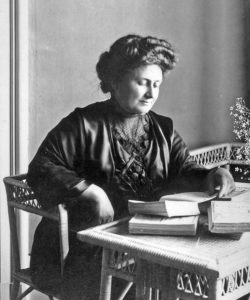At Uzbekistan’s National Centre for the Social Adaptation of Children (NCSAC), children with disabilities and special needs can find the care, services, and attention they need to achieve their full potential. As Uzbekistan’s leading nonprofit dedicated to supporting these underserved youngsters, NCSAC employs a committed team of specialized professionals who work across a wide range of therapeutic disciplines to create the best development approach for each individual child.
One of the many therapies NCSAC offers is Montessori education. Developed by Dr. Maria Montessori in the early years of the 20th century, the Montessori method remains a very popular approach to early childhood education and is increasingly used as a technique for working with children with special needs. Read on to learn more about the basic principles of the Montessori approach and how it can benefit children with disabilities.
What is Montessori education all about?

Dr. Maria Montessori was one of the first pioneers of truly child-centered education. The approach she developed was a holistic one that treated physical, emotional, social, and cognitive growth as equally important. The following are some of the fundamental principles underlying the Montessori method:
Respect for the child—All other Montessori principles rest upon the cornerstone of respect for the child. Lamenting the fact that, all too often, we are overbearing and rude to children and expect them to submissively fall into line, Montessori instead proffered a radical proposition: that we respect children and treat them with exactly the kindness that we want them to develop themselves.
Auto-education—Working from a belief in what she referred to as “the absorbent mind,” Montessori was a strong advocate for the idea that children educate themselves. In essence, she argued, children can’t help learning; simply by living, they are continually absorbing lessons from their environment and constantly sharpening their readiness and ability to learn. The concept of “choice” is an important part of this principle: in Montessori classrooms, children freely choose their work. They decide what to do, do it for as long as they are inspired to, and move on to another activity when they are ready.
Sensitive periods—Alongside the auto-education principle described above, Montessori also believed that children go through what she called “sensitive periods” in which they are more susceptible to particular behaviors and have an easier time learning specific skills (for example, there is a sensitive period for reading, another for writing, etc.). However, while all children experience the same sensitive periods, the timing and sequence of these periods are different for every child.
The prepared environment—The Montessori approach places a great deal of importance on the environment where learning happens. To facilitate children’s natural absorption of lessons from their surroundings, Montessori advocated for a “prepared environment” in which learning materials and experiences are easily and readily available for children to explore and choose from. This helps to foster a learning experience that is independent and active.
How can Montessori education benefit children with special needs?
It’s clear from the previous descriptions of various Montessori principles that there are a number of reasons why this approach is well-suited to serving children with disabilities or special needs. These include the following:
Sensory engagement—Materials in a Montessori classroom are designed to be beautiful and to appeal to all the senses. They are deliberately hands-on and offer an enticing and active therapeutic experience. This can be a great benefit to children with disabilities, as they are free to engage with materials in a way that works for them rather than having to fit into a traditional lesson plan or learning experience. In addition, most materials deliberately teach only one skill at a time, thus preventing children with special needs from becoming overwhelmed.
Multi-age classrooms—Montessori classes contain multi-age groups. This not only allows children with special needs to more easily observe and learn from older children (who may also be better able to offer help), it also makes it easier to “hold back” a child who needs to repeat a grade without removing them from an existing peer group.
Consistency—In a Montessori classroom, students typically remain with the same teacher for a three-year cycle. This helps the teacher build a strong and long-term relationship with both a special needs child and his or her parents. It also takes away the potential stress of having to adapt to a new teacher and a new classroom at the beginning of every school year.
Self-paced learning—For many children with disabilities, it’s the pace of learning, even more so than the skills they are learning, that can be a challenge. But because Montessori students have the freedom to work at their own pace and according to their own inclination, children with special needs don’t have to feel rushed or like they need to keep up with their peers.
An open philosophy—One of the biggest benefits that children with disabilities can experience in a Montessori classroom is a greater level of peace, cooperation, and respect. The fact that the Montessori philosophy emphasizes these traits so highly means that children with special needs are much less likely to be ostracized and much more likely to receive support and encouragement than children in a traditional classroom.

Sorry, comments are closed for this post.